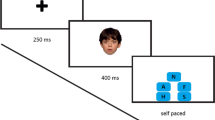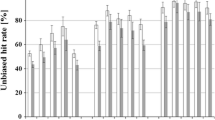Abstract
The objectives of this study were to evaluate both face and emotion recognition, to detect differences among attention deficit and hyperactivity disorder (ADHD) subgroups, to identify effects of the gender and to assess the effects of methylphenidate and atomoxetine treatment on both face and emotion recognition in patients with ADHD. The study sample consisted of 41 male, 29 female patients, 8–15 years of age, who were diagnosed as having combined type ADHD (N = 26), hyperactive/impulsive type ADHD (N = 21) or inattentive type ADHD (N = 23) but had not previously used any medication for ADHD and 35 male, 25 female healthy individuals. Long-acting methylphenidate (OROS-MPH) was prescribed to 38 patients, whereas atomoxetine was prescribed to 32 patients. The reading the mind in the eyes test (RMET) and Benton face recognition test (BFRT) were applied to all participants before and after treatment. The patients with ADHD had a significantly lower number of correct answers in child and adolescent RMET and in BFRT than the healthy controls. Among the ADHD subtypes, the hyperactive/impulsive subtype had a lower number of correct answers in the RMET than the inattentive subtypes, and the hyperactive/impulsive subtype had a lower number of correct answers in short and long form of BFRT than the combined and inattentive subtypes. Male and female patients with ADHD did not differ significantly with respect to the number of correct answers on the RMET and BFRT. The patients showed significant improvement in RMET and BFRT after treatment with OROS-MPH or atomoxetine. Patients with ADHD have difficulties in face recognition as well as emotion recognition. Both OROS-MPH and atomoxetine affect emotion recognition. However, further studies on the face and emotion recognition are needed in ADHD.
Similar content being viewed by others
Change history
21 December 2017
The author would like to correct the error in the publication of the original article. The corrected details are given below for your reading.
References
Aspan N, Bozsik C, Gadoros J et al (2014) Emotion recognition pattern in adolescent boys with attention-deficit/hyperactivity disorder. Biomed Res Int. doi:10.1155/2014/761340
Barkley RA (1997) Behavioral inhibition, sustained attention, and executive functions: constructing a unifying theory of ADHD. Psychol Bull 121:65
Baron-Cohen S, Wheelwright S, Hill J, Raste Y, Plumb I (2001) The ‘‘reading the mind in the eyes’’ test revised version: a study with normal adults, and adults with asperger syndrome or high-functioning autism. J Child Psychol Psychiatry 42:241–251
Benton AL, Sivan AB, Hamsher K, Varney NR, Spreen O (1983) Benton facial recognition: stimulus and multiple choice pictures. Psychological Assessment Resources (PAR), Lutz
Blair R, Morris J, Frith C, Dolan R (1999) Dissociable neural responses to facial expressions of sadness and anger. Brain 122:883
Boakes J, Chapman E, Houghton S, West J (2008) Facial affecti interpretation in boys with attention deficit/hyperactivity disorder. Child Neuropsychol 14:82–96
Brotman MA, Rich BA, Guyer AE et al (2010) Amygdala activation during emotion processing of neutral faces in children with severe mood dysregulation versus ADHD or bipolar disorder. Am J Psychiatry 167:61–69
Castellanos FX, Sharp WS, Gottesman RF, Greenstein DK, Giedd JN, Rapoport JL (2003) Anatomic brain abnormalities in monozygotic twins discordant for attention deficit hyperactivity disorder. Am J Psychiatry 160:1693–1696
Cherkasova MV, Hechtman L (2009) Neuroimaging in attention-deficit hyperactivity disorder: beyond the frontostriatal circuitry. Can J Psychiatry 54:651–663
Combs DR, Adams SD, Penn DL, Roberts D, Tiegreen J, Stem P (2007) Social cognition and interaction training (SCIT) for inpatients with schizophrenia spectrum disorders: preliminary findings. Schizophr Res 91:112–116
Conners CK (2001) Development of the CRS-R. In: Conners CK (ed) Conners’ rating scales—revised. Multi-Health Systems, North Tonawanda, pp 83–98
Fonseca DA, Seguier V, Santos A, Poinso F, Deruelle C (2009) Emotion understanding in children with ADHD. Child Psychiatry Hum Dev 40(1):111–121
Gauthier I, Skudlarski P, Gore JC, Anderson AW (2000) Expertise for cars and birds recruits brain areas involved in face recognition. Nat Neurosci 3:191–197
Gobbini MI, Haxby JV (2007) Neural systems for recognition of familiar faces. Neuropsychologia 45(1):32–41
Greene RW, Biederman J, Faraone SV, Penn C, Griffin SM (1996) Toward a new definition of social disability in children with attention-deficit hyperactivity disorder. J Am Acad Child Adolesc Psychiatry 35:571–578
Guy W (1976) ECDEU assessment manual for psychopharmacology. United States Department of Health, Education, and Welfare, Public Health Service, Alcohol, Drug Abuse, and Mental Health Administration, National Institute of Mental Health, Psychopharmacology Research Branch, Division of Extramural Research Programs, Washington, DC
Hall CW, Peterson AD, Webster RE et al (1999) Perception of nonverbal social cues by regular education, ADHD, and ADHD/LD students. Psychol Sch 36:505–514
Hoffman EA, Haxby JV (2000) Distinct representations of eye gaze and identity in the distributed human neural system for face perception. Nat Neurosci 3(1):80–84
Kanwisher N, Mcdermott J, Chun MM (1997) The fusiform face area: a module in human extrastriate cortex specialized for face perception. J Neurosci 17:4302
Katz-Gold I, Besser A, Priel B (2007) The role of simple emotion recognition skills among school aged boys at risk of ADHD. J Abnorm Child Psychol 35:363–378
Kaufman J, Birmaher B, Brent D, Rao U, Flynn C, Moreci P, Williamson D, Ryan N (1997) Schedule for affective disorders and schizophrenia for school-age children-present and lifetime version (K-SADS-PL): initial reliability and validity data. J Am Acad Child Adolesc Psychiatry 367:980–988
Kesler-West ML, Andersen AH, Smith CD et al. (2001) Neural substrates of facial emotion processing using fMRI. Brain Res Cogn Brain Res 11:213–226
Loughland CM, Williams LM, Gordon E (2002) Visual scanpaths to positive and negative facial emotions in an outpatient schizophrenia sample. Schizophr Res 55:159–170
Marsh AA, Finger EC, Mitchell DGV et al (2008) Reduced amygdala response to fearful expressions in children and adolescents with callous-unemotional traits and disruptive behavior disorders. Am J Psychiatry 165:712–720
Mcalonan G, Cheung V, Chua S et al (2009) Age-related grey matter volume correlates of response inhibition and shifting in attention-deficit hyperactivity disorder. Br J Psychiatry 194:123–129
Owens EB, Hinshaw SP, Lee SS, Lahey BB (2009) Few girls with childhood attention-deficit/hyperactivity disorder show positive adjustment in adolescence. J Clin Child Psychol 38:132–143
Passarotti AM, Sweeney JA, Pavuluri MN (2010) Emotion processing influences working memory circuits in pediatric bipolar disorder and attention-deficit hyperactivity disorder. J Am Acad Child Adolesc Psychiatry 49:1064–1080
Pelc K, Kornreich C, Foisy ML, Dan B (2006) Recognition of emotional facial expressions in attention-deficit hyperactivity disorder. Pediatr Neurol 35:93–97
Phillips ML, Drevets WC, Rauch SL, Lane R (2003) Neurobiology of emotion perception I: the neural basis of normal emotion perception. Biol Psychiatry 54:504–514
Rotshtein P, Malach R, Hadar U, Graif M, Hendler T (2001) Feeling or features: different sensitivity to emotion in high-order visual cortex and amygdala. Neuron 32:747–757
Rubia K, Alegría AA, Brinson H (2014) Brain abnormalities in attention deficit hyperactivity disorder: a review. Rev Neurol 58(1):3–16
Said CP, Haxby JV, Todorov A (2011) Brain systems for assessing the affective value of faces. Philos Trans R Soc Lond B Biol Sci 366(1571):1660–1670
Schwenck C, Schmitt D, Sievers S, Romanos M, Warnke A, Schneider W (2011) Cognitive and emotional empathy in children with ADHD and conduct disorder. Z Kinder Jugendpsychiatr Psychother 39(4):265–276
Schwenck C, Schneider T, Schreckenbach J et al (2013) Emotion recognition in children and adolescents with attention-deficit/hyperactivity disorder (ADHD). Atten Defic Hyperact Disord 5(3):295–302
Singh SD, Ellis CR, Winton AS, Singh NN, Leung JP, Oswald DP (1998) Recognition of facial expressions of emotion by children with attention-deficit hyperactivity disorder. Behav Modif 22(2):128–142
Sinzig J, Morsch D, Lehmkuhl G (2008) Do hyperactivity, impulsivity and inattention have an impact on the ability of facial affect recognition in children with autism and ADHD? Eur Child Adolesc Psychiatry 17(2):63–72
Solanto MV, Pope-Boyd SA, Tryon WW, Stepak B (2009) Social functioning in predominantly inattentive and combined subtypes of children with ADHD. J Atten Disord 13:27–35
Spencer T, Biederman J, Wilens T et al (2005) A large, double-blind, randomized clinical trial of methylphenidate in the treatment of adults with attention deficit/hyperactivity disorder. Biol Psychiatry 57:456–463
Stanghellini G, Ballerini M, Criterion B (2007) Social dysfunction in persons with schizophrenia: the puzzle. Curr Opin Psychiatry 20:582
Subhashni D (1998) Recognition of Facial Expressions of Emotion by Children with ADHD. Behav Modif 22:128–142
Surguladze SA, Brammer MJ, Young AW et al. (2003) A preferential increase in the extrastriate response to signals of danger. Neuroimage 19(4):1317–1328
Thomas LA, De Bellis MD, Graham R, La Bar KS (2007) Development of emotional facial recognition in late childhood and adolescence. Dev Sci 10:547–558
Uekermann J, Kraemer M, Abdel-Hamid M et al (2010) Social cognition in attention-deficit hyperactivity disorder (ADHD). Neurosci Biobehav Rev 34(5):734–743
Von Morgenstern SB, Becker I, Sinzig J (2014) Improvement of facial affect recognition in children and adolescents with attention-deficit/hyperactivity disorder under methylphenidate. Acta Neuropsychiatr 26(4):202–208
Wechsler D (1974) Manual for the Wechsler intelligence scale for children, revised. Psychological Corporation, New york
Williams LM, Hermens DF, Palmer D et al (2008) Misinterpreting emotional expressions in attention deficit hyperactivity disorder: evidence for a neural marker and stimulant effects. Biol Psychiatry 63(10):917–926
Williams L, Mathersul D, Palmer DM, Gur RC, Gur RE, Gordon E (2009) Explicit identification and implicit recognition of facial emotions: I. Age effects in males and females across 10 decades. J Clin Exp Neuropsychol 31(3):257–277
Yuill N, Lyon J (2007) Selective difficulty in recognising facial expressions of emotion in boys with ADHD: general performance impairments or specific problems in social cognition? Eur Child Adolesc Psychiatry 16(6):398–404
Acknowledgments
The authors thank Dr Ferhan Elmalı PhD for help with the statistical analysis. The RMET test was devised by the Autism Research Centre (ARC) for use during the course of our research.
Author information
Authors and Affiliations
Corresponding author
Ethics declarations
Conflict of interest
All authors declare no biomedical financial interests or potential conflicts of interest.
Additional information
A correction to this article is available online at https://doi.org/10.1007/s12402-017-0247-4.
Rights and permissions
About this article
Cite this article
Demirci, E., Erdogan, A. Is emotion recognition the only problem in ADHD? effects of pharmacotherapy on face and emotion recognition in children with ADHD. ADHD Atten Def Hyp Disord 8, 197–204 (2016). https://doi.org/10.1007/s12402-016-0201-x
Received:
Accepted:
Published:
Issue Date:
DOI: https://doi.org/10.1007/s12402-016-0201-x




